Substance Abuse Among Young People in Australia
VerifiedAdded on 2023/03/17
|16
|4855
|95
AI Summary
This essay discusses how substance misuse and addiction affect youths in Australia, including social determinants, policy, and stakeholders involved.
Contribute Materials
Your contribution can guide someone’s learning journey. Share your
documents today.
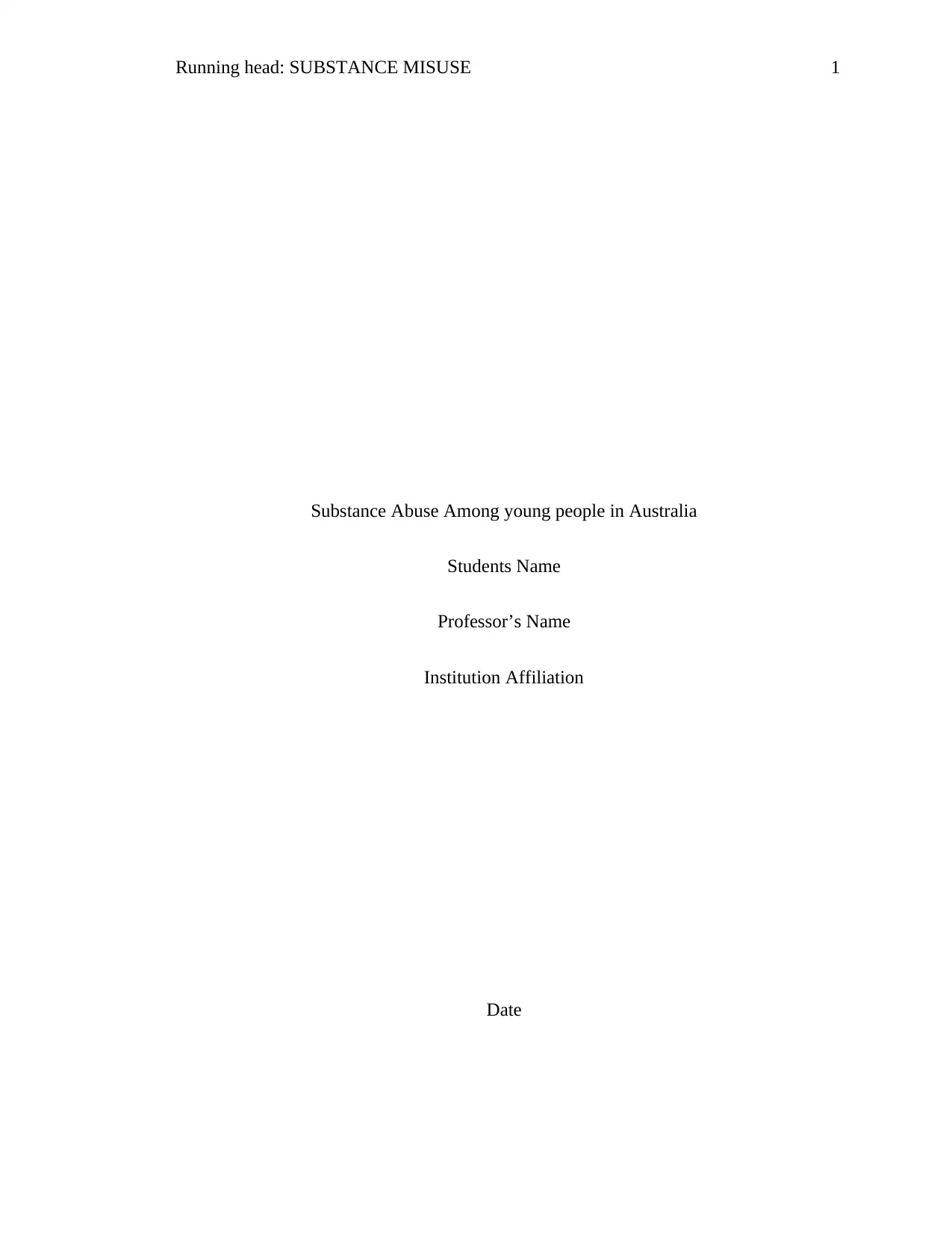
Running head: SUBSTANCE MISUSE 1
Substance Abuse Among young people in Australia
Students Name
Professor’s Name
Institution Affiliation
Date
Substance Abuse Among young people in Australia
Students Name
Professor’s Name
Institution Affiliation
Date
Secure Best Marks with AI Grader
Need help grading? Try our AI Grader for instant feedback on your assignments.
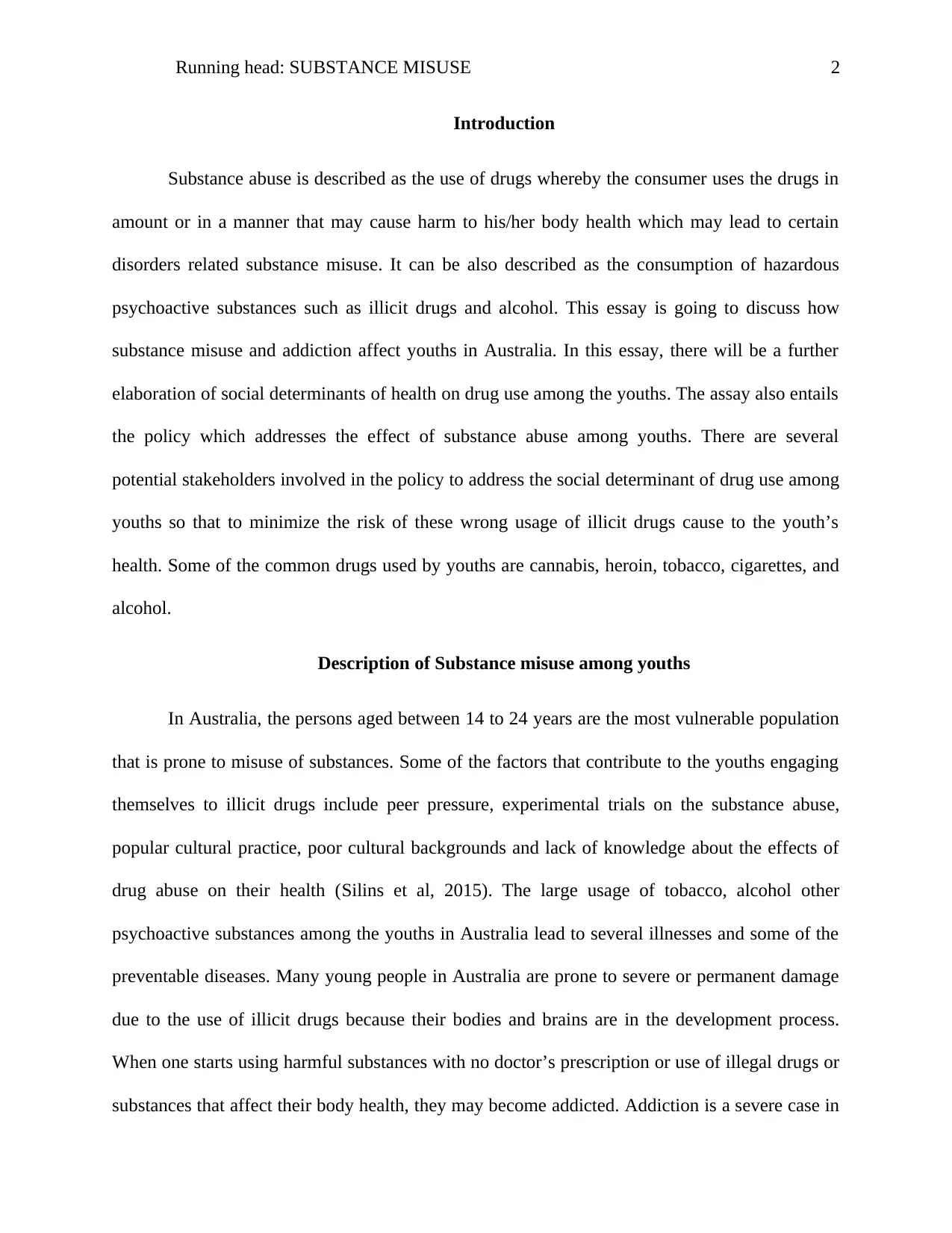
Running head: SUBSTANCE MISUSE 2
Introduction
Substance abuse is described as the use of drugs whereby the consumer uses the drugs in
amount or in a manner that may cause harm to his/her body health which may lead to certain
disorders related substance misuse. It can be also described as the consumption of hazardous
psychoactive substances such as illicit drugs and alcohol. This essay is going to discuss how
substance misuse and addiction affect youths in Australia. In this essay, there will be a further
elaboration of social determinants of health on drug use among the youths. The assay also entails
the policy which addresses the effect of substance abuse among youths. There are several
potential stakeholders involved in the policy to address the social determinant of drug use among
youths so that to minimize the risk of these wrong usage of illicit drugs cause to the youth’s
health. Some of the common drugs used by youths are cannabis, heroin, tobacco, cigarettes, and
alcohol.
Description of Substance misuse among youths
In Australia, the persons aged between 14 to 24 years are the most vulnerable population
that is prone to misuse of substances. Some of the factors that contribute to the youths engaging
themselves to illicit drugs include peer pressure, experimental trials on the substance abuse,
popular cultural practice, poor cultural backgrounds and lack of knowledge about the effects of
drug abuse on their health (Silins et al, 2015). The large usage of tobacco, alcohol other
psychoactive substances among the youths in Australia lead to several illnesses and some of the
preventable diseases. Many young people in Australia are prone to severe or permanent damage
due to the use of illicit drugs because their bodies and brains are in the development process.
When one starts using harmful substances with no doctor’s prescription or use of illegal drugs or
substances that affect their body health, they may become addicted. Addiction is a severe case in
Introduction
Substance abuse is described as the use of drugs whereby the consumer uses the drugs in
amount or in a manner that may cause harm to his/her body health which may lead to certain
disorders related substance misuse. It can be also described as the consumption of hazardous
psychoactive substances such as illicit drugs and alcohol. This essay is going to discuss how
substance misuse and addiction affect youths in Australia. In this essay, there will be a further
elaboration of social determinants of health on drug use among the youths. The assay also entails
the policy which addresses the effect of substance abuse among youths. There are several
potential stakeholders involved in the policy to address the social determinant of drug use among
youths so that to minimize the risk of these wrong usage of illicit drugs cause to the youth’s
health. Some of the common drugs used by youths are cannabis, heroin, tobacco, cigarettes, and
alcohol.
Description of Substance misuse among youths
In Australia, the persons aged between 14 to 24 years are the most vulnerable population
that is prone to misuse of substances. Some of the factors that contribute to the youths engaging
themselves to illicit drugs include peer pressure, experimental trials on the substance abuse,
popular cultural practice, poor cultural backgrounds and lack of knowledge about the effects of
drug abuse on their health (Silins et al, 2015). The large usage of tobacco, alcohol other
psychoactive substances among the youths in Australia lead to several illnesses and some of the
preventable diseases. Many young people in Australia are prone to severe or permanent damage
due to the use of illicit drugs because their bodies and brains are in the development process.
When one starts using harmful substances with no doctor’s prescription or use of illegal drugs or
substances that affect their body health, they may become addicted. Addiction is a severe case in
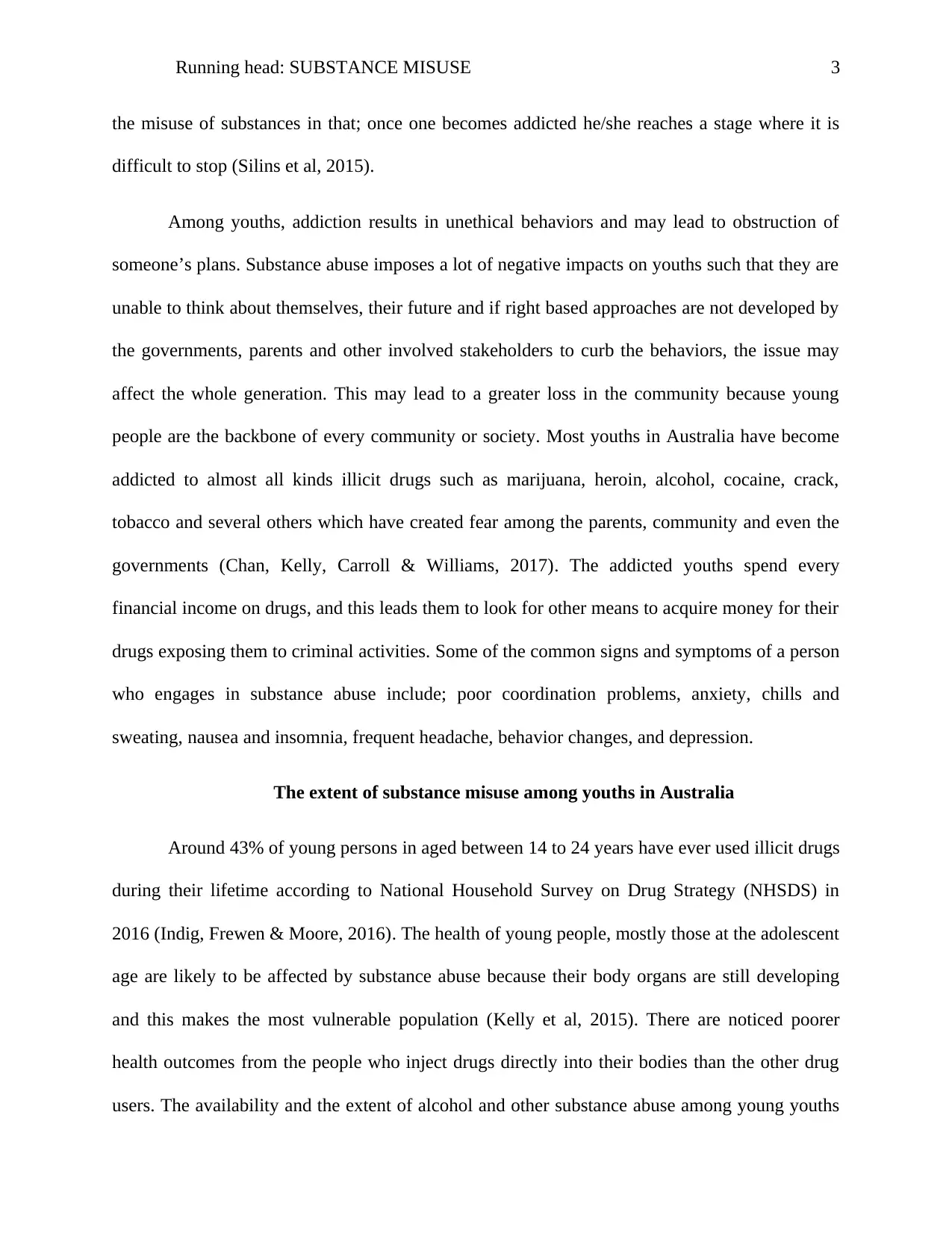
Running head: SUBSTANCE MISUSE 3
the misuse of substances in that; once one becomes addicted he/she reaches a stage where it is
difficult to stop (Silins et al, 2015).
Among youths, addiction results in unethical behaviors and may lead to obstruction of
someone’s plans. Substance abuse imposes a lot of negative impacts on youths such that they are
unable to think about themselves, their future and if right based approaches are not developed by
the governments, parents and other involved stakeholders to curb the behaviors, the issue may
affect the whole generation. This may lead to a greater loss in the community because young
people are the backbone of every community or society. Most youths in Australia have become
addicted to almost all kinds illicit drugs such as marijuana, heroin, alcohol, cocaine, crack,
tobacco and several others which have created fear among the parents, community and even the
governments (Chan, Kelly, Carroll & Williams, 2017). The addicted youths spend every
financial income on drugs, and this leads them to look for other means to acquire money for their
drugs exposing them to criminal activities. Some of the common signs and symptoms of a person
who engages in substance abuse include; poor coordination problems, anxiety, chills and
sweating, nausea and insomnia, frequent headache, behavior changes, and depression.
The extent of substance misuse among youths in Australia
Around 43% of young persons in aged between 14 to 24 years have ever used illicit drugs
during their lifetime according to National Household Survey on Drug Strategy (NHSDS) in
2016 (Indig, Frewen & Moore, 2016). The health of young people, mostly those at the adolescent
age are likely to be affected by substance abuse because their body organs are still developing
and this makes the most vulnerable population (Kelly et al, 2015). There are noticed poorer
health outcomes from the people who inject drugs directly into their bodies than the other drug
users. The availability and the extent of alcohol and other substance abuse among young youths
the misuse of substances in that; once one becomes addicted he/she reaches a stage where it is
difficult to stop (Silins et al, 2015).
Among youths, addiction results in unethical behaviors and may lead to obstruction of
someone’s plans. Substance abuse imposes a lot of negative impacts on youths such that they are
unable to think about themselves, their future and if right based approaches are not developed by
the governments, parents and other involved stakeholders to curb the behaviors, the issue may
affect the whole generation. This may lead to a greater loss in the community because young
people are the backbone of every community or society. Most youths in Australia have become
addicted to almost all kinds illicit drugs such as marijuana, heroin, alcohol, cocaine, crack,
tobacco and several others which have created fear among the parents, community and even the
governments (Chan, Kelly, Carroll & Williams, 2017). The addicted youths spend every
financial income on drugs, and this leads them to look for other means to acquire money for their
drugs exposing them to criminal activities. Some of the common signs and symptoms of a person
who engages in substance abuse include; poor coordination problems, anxiety, chills and
sweating, nausea and insomnia, frequent headache, behavior changes, and depression.
The extent of substance misuse among youths in Australia
Around 43% of young persons in aged between 14 to 24 years have ever used illicit drugs
during their lifetime according to National Household Survey on Drug Strategy (NHSDS) in
2016 (Indig, Frewen & Moore, 2016). The health of young people, mostly those at the adolescent
age are likely to be affected by substance abuse because their body organs are still developing
and this makes the most vulnerable population (Kelly et al, 2015). There are noticed poorer
health outcomes from the people who inject drugs directly into their bodies than the other drug
users. The availability and the extent of alcohol and other substance abuse among young youths
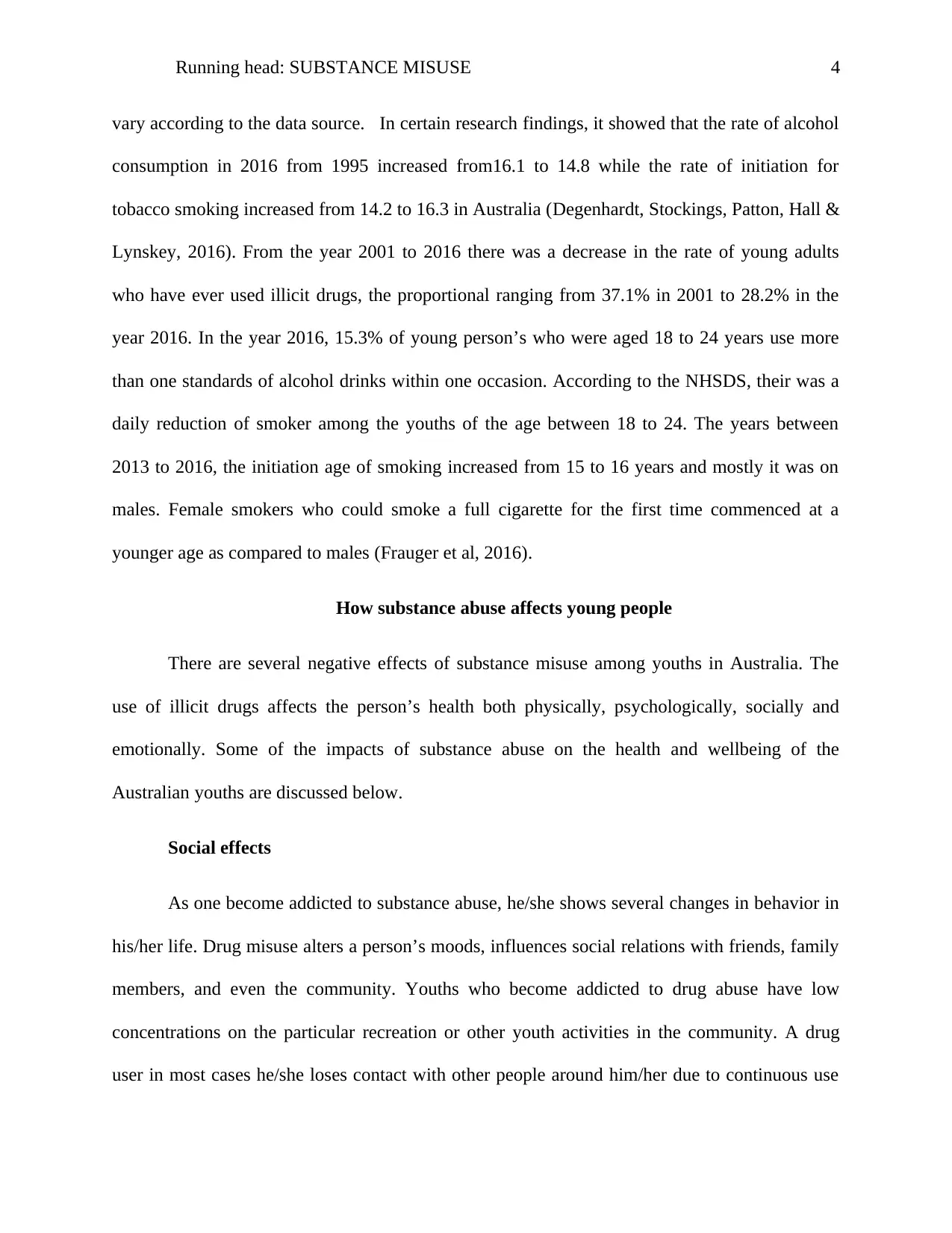
Running head: SUBSTANCE MISUSE 4
vary according to the data source. In certain research findings, it showed that the rate of alcohol
consumption in 2016 from 1995 increased from16.1 to 14.8 while the rate of initiation for
tobacco smoking increased from 14.2 to 16.3 in Australia (Degenhardt, Stockings, Patton, Hall &
Lynskey, 2016). From the year 2001 to 2016 there was a decrease in the rate of young adults
who have ever used illicit drugs, the proportional ranging from 37.1% in 2001 to 28.2% in the
year 2016. In the year 2016, 15.3% of young person’s who were aged 18 to 24 years use more
than one standards of alcohol drinks within one occasion. According to the NHSDS, their was a
daily reduction of smoker among the youths of the age between 18 to 24. The years between
2013 to 2016, the initiation age of smoking increased from 15 to 16 years and mostly it was on
males. Female smokers who could smoke a full cigarette for the first time commenced at a
younger age as compared to males (Frauger et al, 2016).
How substance abuse affects young people
There are several negative effects of substance misuse among youths in Australia. The
use of illicit drugs affects the person’s health both physically, psychologically, socially and
emotionally. Some of the impacts of substance abuse on the health and wellbeing of the
Australian youths are discussed below.
Social effects
As one become addicted to substance abuse, he/she shows several changes in behavior in
his/her life. Drug misuse alters a person’s moods, influences social relations with friends, family
members, and even the community. Youths who become addicted to drug abuse have low
concentrations on the particular recreation or other youth activities in the community. A drug
user in most cases he/she loses contact with other people around him/her due to continuous use
vary according to the data source. In certain research findings, it showed that the rate of alcohol
consumption in 2016 from 1995 increased from16.1 to 14.8 while the rate of initiation for
tobacco smoking increased from 14.2 to 16.3 in Australia (Degenhardt, Stockings, Patton, Hall &
Lynskey, 2016). From the year 2001 to 2016 there was a decrease in the rate of young adults
who have ever used illicit drugs, the proportional ranging from 37.1% in 2001 to 28.2% in the
year 2016. In the year 2016, 15.3% of young person’s who were aged 18 to 24 years use more
than one standards of alcohol drinks within one occasion. According to the NHSDS, their was a
daily reduction of smoker among the youths of the age between 18 to 24. The years between
2013 to 2016, the initiation age of smoking increased from 15 to 16 years and mostly it was on
males. Female smokers who could smoke a full cigarette for the first time commenced at a
younger age as compared to males (Frauger et al, 2016).
How substance abuse affects young people
There are several negative effects of substance misuse among youths in Australia. The
use of illicit drugs affects the person’s health both physically, psychologically, socially and
emotionally. Some of the impacts of substance abuse on the health and wellbeing of the
Australian youths are discussed below.
Social effects
As one become addicted to substance abuse, he/she shows several changes in behavior in
his/her life. Drug misuse alters a person’s moods, influences social relations with friends, family
members, and even the community. Youths who become addicted to drug abuse have low
concentrations on the particular recreation or other youth activities in the community. A drug
user in most cases he/she loses contact with other people around him/her due to continuous use
Secure Best Marks with AI Grader
Need help grading? Try our AI Grader for instant feedback on your assignments.
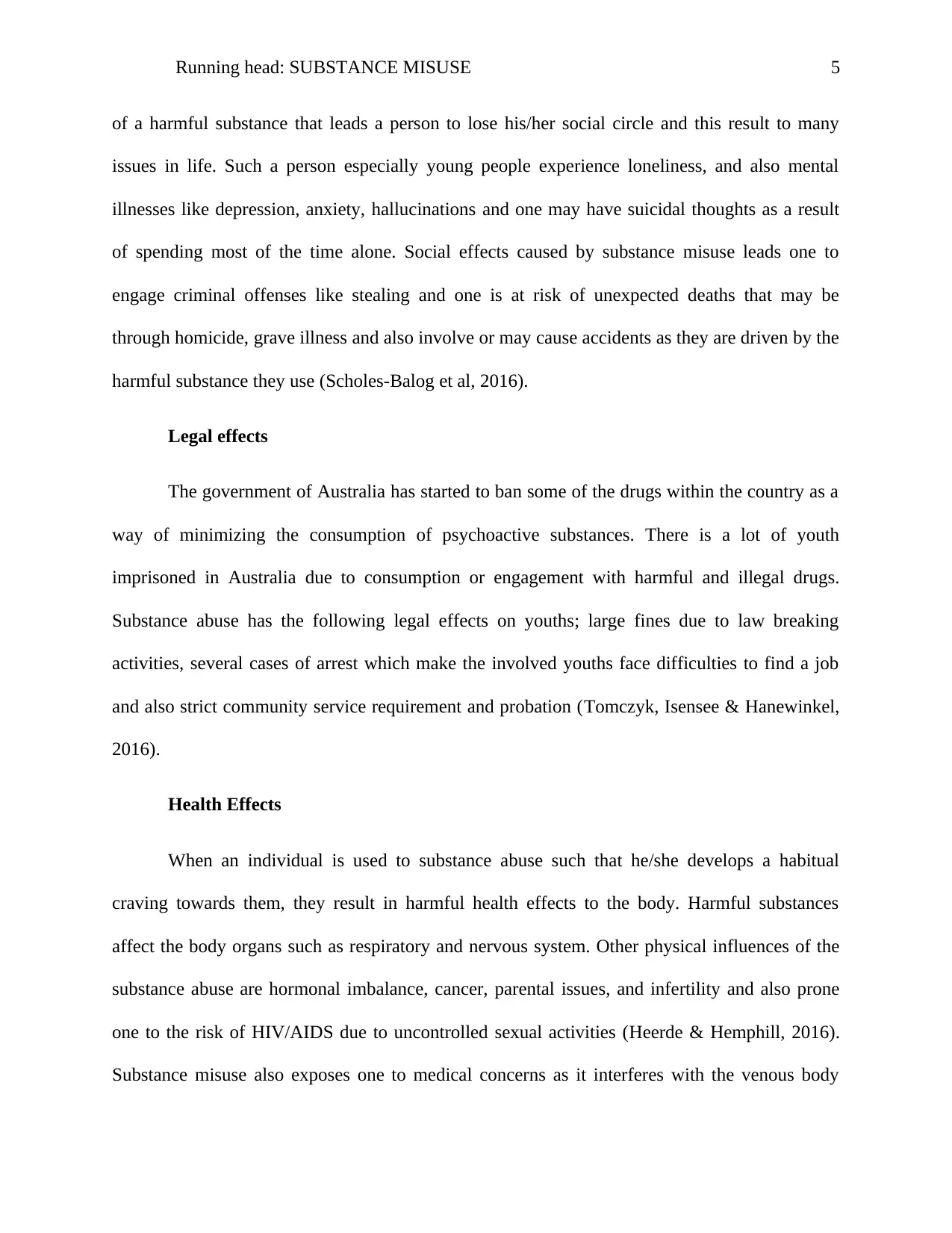
Running head: SUBSTANCE MISUSE 5
of a harmful substance that leads a person to lose his/her social circle and this result to many
issues in life. Such a person especially young people experience loneliness, and also mental
illnesses like depression, anxiety, hallucinations and one may have suicidal thoughts as a result
of spending most of the time alone. Social effects caused by substance misuse leads one to
engage criminal offenses like stealing and one is at risk of unexpected deaths that may be
through homicide, grave illness and also involve or may cause accidents as they are driven by the
harmful substance they use (Scholes-Balog et al, 2016).
Legal effects
The government of Australia has started to ban some of the drugs within the country as a
way of minimizing the consumption of psychoactive substances. There is a lot of youth
imprisoned in Australia due to consumption or engagement with harmful and illegal drugs.
Substance abuse has the following legal effects on youths; large fines due to law breaking
activities, several cases of arrest which make the involved youths face difficulties to find a job
and also strict community service requirement and probation (Tomczyk, Isensee & Hanewinkel,
2016).
Health Effects
When an individual is used to substance abuse such that he/she develops a habitual
craving towards them, they result in harmful health effects to the body. Harmful substances
affect the body organs such as respiratory and nervous system. Other physical influences of the
substance abuse are hormonal imbalance, cancer, parental issues, and infertility and also prone
one to the risk of HIV/AIDS due to uncontrolled sexual activities (Heerde & Hemphill, 2016).
Substance misuse also exposes one to medical concerns as it interferes with the venous body
of a harmful substance that leads a person to lose his/her social circle and this result to many
issues in life. Such a person especially young people experience loneliness, and also mental
illnesses like depression, anxiety, hallucinations and one may have suicidal thoughts as a result
of spending most of the time alone. Social effects caused by substance misuse leads one to
engage criminal offenses like stealing and one is at risk of unexpected deaths that may be
through homicide, grave illness and also involve or may cause accidents as they are driven by the
harmful substance they use (Scholes-Balog et al, 2016).
Legal effects
The government of Australia has started to ban some of the drugs within the country as a
way of minimizing the consumption of psychoactive substances. There is a lot of youth
imprisoned in Australia due to consumption or engagement with harmful and illegal drugs.
Substance abuse has the following legal effects on youths; large fines due to law breaking
activities, several cases of arrest which make the involved youths face difficulties to find a job
and also strict community service requirement and probation (Tomczyk, Isensee & Hanewinkel,
2016).
Health Effects
When an individual is used to substance abuse such that he/she develops a habitual
craving towards them, they result in harmful health effects to the body. Harmful substances
affect the body organs such as respiratory and nervous system. Other physical influences of the
substance abuse are hormonal imbalance, cancer, parental issues, and infertility and also prone
one to the risk of HIV/AIDS due to uncontrolled sexual activities (Heerde & Hemphill, 2016).
Substance misuse also exposes one to medical concerns as it interferes with the venous body
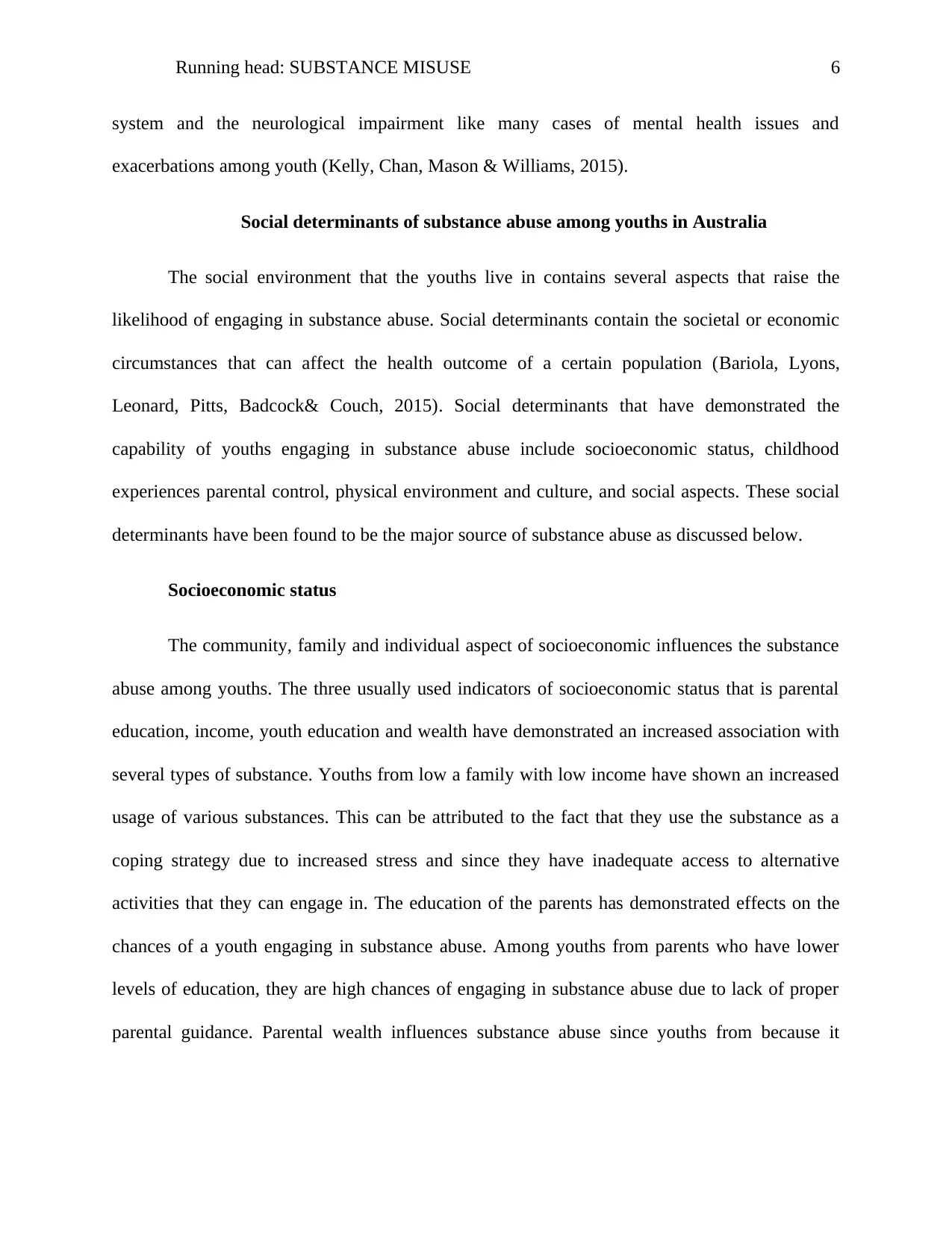
Running head: SUBSTANCE MISUSE 6
system and the neurological impairment like many cases of mental health issues and
exacerbations among youth (Kelly, Chan, Mason & Williams, 2015).
Social determinants of substance abuse among youths in Australia
The social environment that the youths live in contains several aspects that raise the
likelihood of engaging in substance abuse. Social determinants contain the societal or economic
circumstances that can affect the health outcome of a certain population (Bariola, Lyons,
Leonard, Pitts, Badcock& Couch, 2015). Social determinants that have demonstrated the
capability of youths engaging in substance abuse include socioeconomic status, childhood
experiences parental control, physical environment and culture, and social aspects. These social
determinants have been found to be the major source of substance abuse as discussed below.
Socioeconomic status
The community, family and individual aspect of socioeconomic influences the substance
abuse among youths. The three usually used indicators of socioeconomic status that is parental
education, income, youth education and wealth have demonstrated an increased association with
several types of substance. Youths from low a family with low income have shown an increased
usage of various substances. This can be attributed to the fact that they use the substance as a
coping strategy due to increased stress and since they have inadequate access to alternative
activities that they can engage in. The education of the parents has demonstrated effects on the
chances of a youth engaging in substance abuse. Among youths from parents who have lower
levels of education, they are high chances of engaging in substance abuse due to lack of proper
parental guidance. Parental wealth influences substance abuse since youths from because it
system and the neurological impairment like many cases of mental health issues and
exacerbations among youth (Kelly, Chan, Mason & Williams, 2015).
Social determinants of substance abuse among youths in Australia
The social environment that the youths live in contains several aspects that raise the
likelihood of engaging in substance abuse. Social determinants contain the societal or economic
circumstances that can affect the health outcome of a certain population (Bariola, Lyons,
Leonard, Pitts, Badcock& Couch, 2015). Social determinants that have demonstrated the
capability of youths engaging in substance abuse include socioeconomic status, childhood
experiences parental control, physical environment and culture, and social aspects. These social
determinants have been found to be the major source of substance abuse as discussed below.
Socioeconomic status
The community, family and individual aspect of socioeconomic influences the substance
abuse among youths. The three usually used indicators of socioeconomic status that is parental
education, income, youth education and wealth have demonstrated an increased association with
several types of substance. Youths from low a family with low income have shown an increased
usage of various substances. This can be attributed to the fact that they use the substance as a
coping strategy due to increased stress and since they have inadequate access to alternative
activities that they can engage in. The education of the parents has demonstrated effects on the
chances of a youth engaging in substance abuse. Among youths from parents who have lower
levels of education, they are high chances of engaging in substance abuse due to lack of proper
parental guidance. Parental wealth influences substance abuse since youths from because it
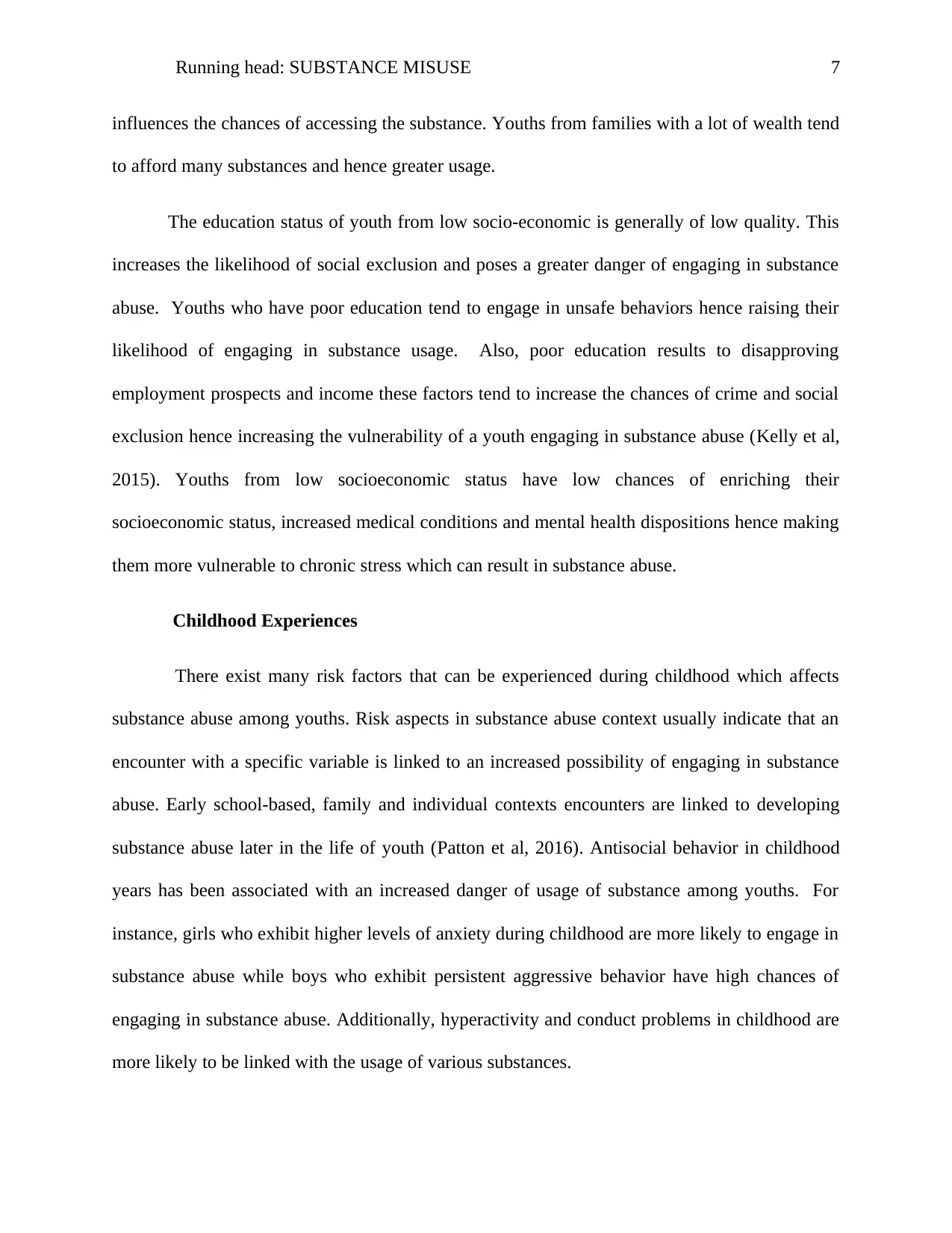
Running head: SUBSTANCE MISUSE 7
influences the chances of accessing the substance. Youths from families with a lot of wealth tend
to afford many substances and hence greater usage.
The education status of youth from low socio-economic is generally of low quality. This
increases the likelihood of social exclusion and poses a greater danger of engaging in substance
abuse. Youths who have poor education tend to engage in unsafe behaviors hence raising their
likelihood of engaging in substance usage. Also, poor education results to disapproving
employment prospects and income these factors tend to increase the chances of crime and social
exclusion hence increasing the vulnerability of a youth engaging in substance abuse (Kelly et al,
2015). Youths from low socioeconomic status have low chances of enriching their
socioeconomic status, increased medical conditions and mental health dispositions hence making
them more vulnerable to chronic stress which can result in substance abuse.
Childhood Experiences
There exist many risk factors that can be experienced during childhood which affects
substance abuse among youths. Risk aspects in substance abuse context usually indicate that an
encounter with a specific variable is linked to an increased possibility of engaging in substance
abuse. Early school-based, family and individual contexts encounters are linked to developing
substance abuse later in the life of youth (Patton et al, 2016). Antisocial behavior in childhood
years has been associated with an increased danger of usage of substance among youths. For
instance, girls who exhibit higher levels of anxiety during childhood are more likely to engage in
substance abuse while boys who exhibit persistent aggressive behavior have high chances of
engaging in substance abuse. Additionally, hyperactivity and conduct problems in childhood are
more likely to be linked with the usage of various substances.
influences the chances of accessing the substance. Youths from families with a lot of wealth tend
to afford many substances and hence greater usage.
The education status of youth from low socio-economic is generally of low quality. This
increases the likelihood of social exclusion and poses a greater danger of engaging in substance
abuse. Youths who have poor education tend to engage in unsafe behaviors hence raising their
likelihood of engaging in substance usage. Also, poor education results to disapproving
employment prospects and income these factors tend to increase the chances of crime and social
exclusion hence increasing the vulnerability of a youth engaging in substance abuse (Kelly et al,
2015). Youths from low socioeconomic status have low chances of enriching their
socioeconomic status, increased medical conditions and mental health dispositions hence making
them more vulnerable to chronic stress which can result in substance abuse.
Childhood Experiences
There exist many risk factors that can be experienced during childhood which affects
substance abuse among youths. Risk aspects in substance abuse context usually indicate that an
encounter with a specific variable is linked to an increased possibility of engaging in substance
abuse. Early school-based, family and individual contexts encounters are linked to developing
substance abuse later in the life of youth (Patton et al, 2016). Antisocial behavior in childhood
years has been associated with an increased danger of usage of substance among youths. For
instance, girls who exhibit higher levels of anxiety during childhood are more likely to engage in
substance abuse while boys who exhibit persistent aggressive behavior have high chances of
engaging in substance abuse. Additionally, hyperactivity and conduct problems in childhood are
more likely to be linked with the usage of various substances.
Paraphrase This Document
Need a fresh take? Get an instant paraphrase of this document with our AI Paraphraser
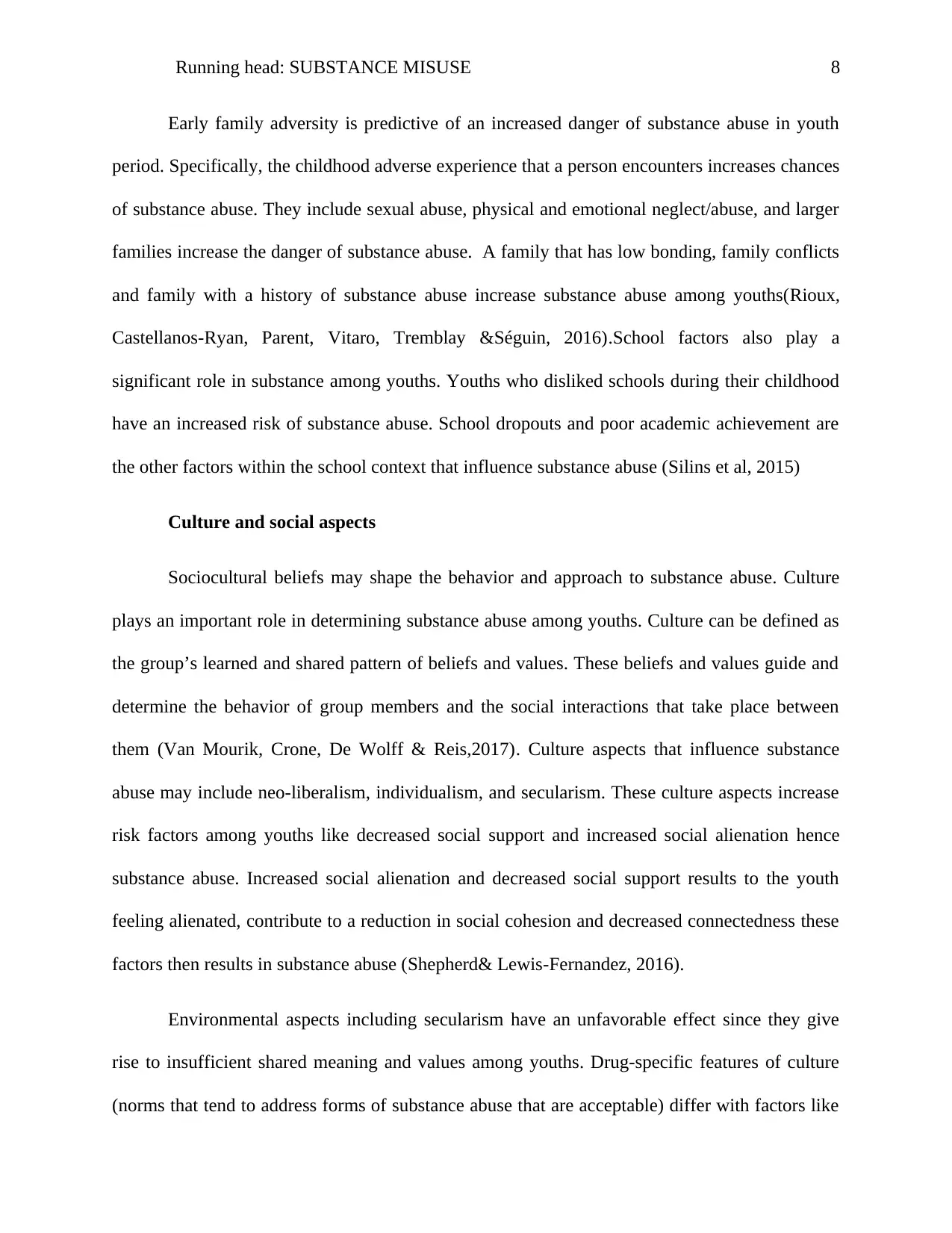
Running head: SUBSTANCE MISUSE 8
Early family adversity is predictive of an increased danger of substance abuse in youth
period. Specifically, the childhood adverse experience that a person encounters increases chances
of substance abuse. They include sexual abuse, physical and emotional neglect/abuse, and larger
families increase the danger of substance abuse. A family that has low bonding, family conflicts
and family with a history of substance abuse increase substance abuse among youths(Rioux,
Castellanos-Ryan, Parent, Vitaro, Tremblay &Séguin, 2016).School factors also play a
significant role in substance among youths. Youths who disliked schools during their childhood
have an increased risk of substance abuse. School dropouts and poor academic achievement are
the other factors within the school context that influence substance abuse (Silins et al, 2015)
Culture and social aspects
Sociocultural beliefs may shape the behavior and approach to substance abuse. Culture
plays an important role in determining substance abuse among youths. Culture can be defined as
the group’s learned and shared pattern of beliefs and values. These beliefs and values guide and
determine the behavior of group members and the social interactions that take place between
them (Van Mourik, Crone, De Wolff & Reis,2017). Culture aspects that influence substance
abuse may include neo-liberalism, individualism, and secularism. These culture aspects increase
risk factors among youths like decreased social support and increased social alienation hence
substance abuse. Increased social alienation and decreased social support results to the youth
feeling alienated, contribute to a reduction in social cohesion and decreased connectedness these
factors then results in substance abuse (Shepherd& Lewis-Fernandez, 2016).
Environmental aspects including secularism have an unfavorable effect since they give
rise to insufficient shared meaning and values among youths. Drug-specific features of culture
(norms that tend to address forms of substance abuse that are acceptable) differ with factors like
Early family adversity is predictive of an increased danger of substance abuse in youth
period. Specifically, the childhood adverse experience that a person encounters increases chances
of substance abuse. They include sexual abuse, physical and emotional neglect/abuse, and larger
families increase the danger of substance abuse. A family that has low bonding, family conflicts
and family with a history of substance abuse increase substance abuse among youths(Rioux,
Castellanos-Ryan, Parent, Vitaro, Tremblay &Séguin, 2016).School factors also play a
significant role in substance among youths. Youths who disliked schools during their childhood
have an increased risk of substance abuse. School dropouts and poor academic achievement are
the other factors within the school context that influence substance abuse (Silins et al, 2015)
Culture and social aspects
Sociocultural beliefs may shape the behavior and approach to substance abuse. Culture
plays an important role in determining substance abuse among youths. Culture can be defined as
the group’s learned and shared pattern of beliefs and values. These beliefs and values guide and
determine the behavior of group members and the social interactions that take place between
them (Van Mourik, Crone, De Wolff & Reis,2017). Culture aspects that influence substance
abuse may include neo-liberalism, individualism, and secularism. These culture aspects increase
risk factors among youths like decreased social support and increased social alienation hence
substance abuse. Increased social alienation and decreased social support results to the youth
feeling alienated, contribute to a reduction in social cohesion and decreased connectedness these
factors then results in substance abuse (Shepherd& Lewis-Fernandez, 2016).
Environmental aspects including secularism have an unfavorable effect since they give
rise to insufficient shared meaning and values among youths. Drug-specific features of culture
(norms that tend to address forms of substance abuse that are acceptable) differ with factors like
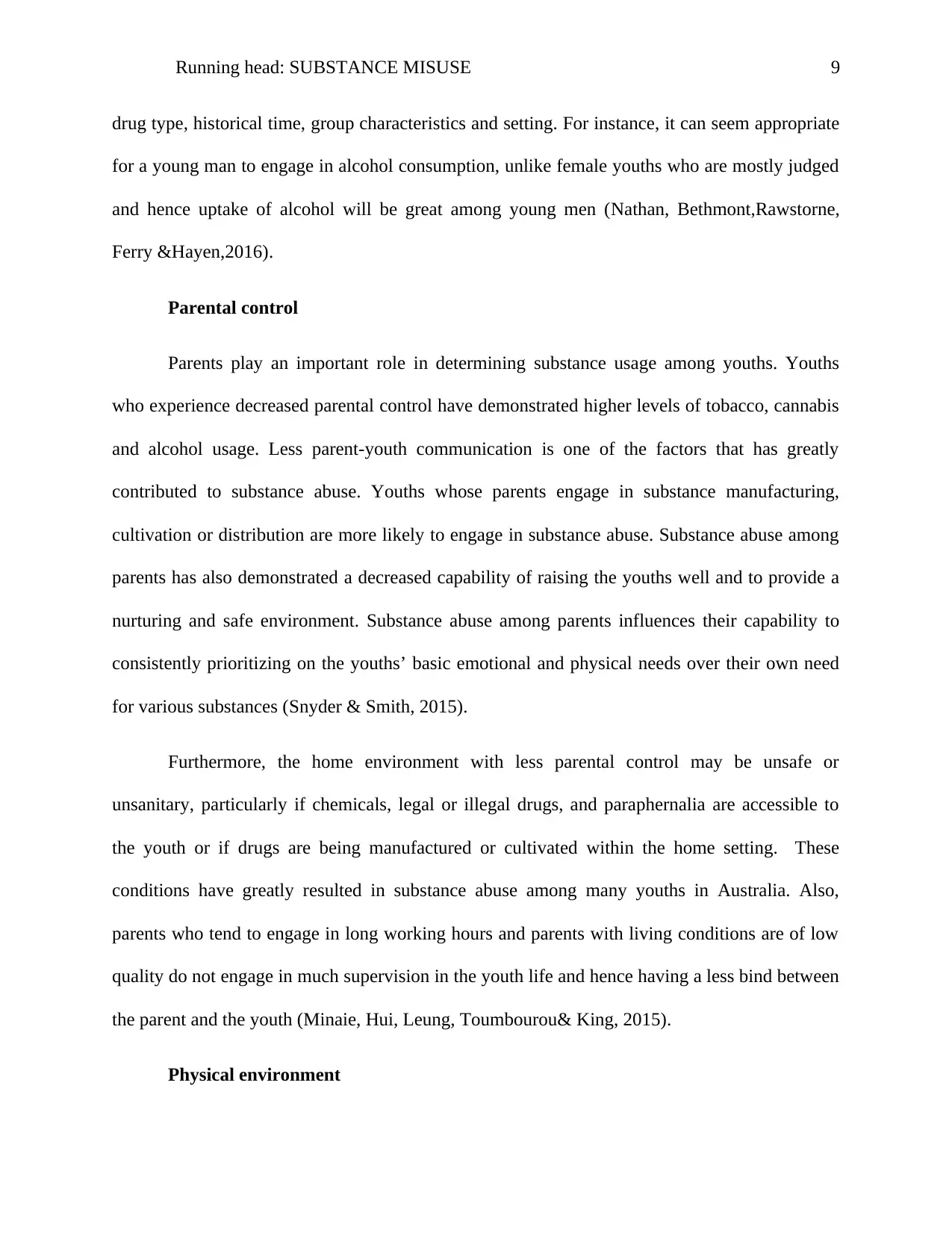
Running head: SUBSTANCE MISUSE 9
drug type, historical time, group characteristics and setting. For instance, it can seem appropriate
for a young man to engage in alcohol consumption, unlike female youths who are mostly judged
and hence uptake of alcohol will be great among young men (Nathan, Bethmont,Rawstorne,
Ferry &Hayen,2016).
Parental control
Parents play an important role in determining substance usage among youths. Youths
who experience decreased parental control have demonstrated higher levels of tobacco, cannabis
and alcohol usage. Less parent-youth communication is one of the factors that has greatly
contributed to substance abuse. Youths whose parents engage in substance manufacturing,
cultivation or distribution are more likely to engage in substance abuse. Substance abuse among
parents has also demonstrated a decreased capability of raising the youths well and to provide a
nurturing and safe environment. Substance abuse among parents influences their capability to
consistently prioritizing on the youths’ basic emotional and physical needs over their own need
for various substances (Snyder & Smith, 2015).
Furthermore, the home environment with less parental control may be unsafe or
unsanitary, particularly if chemicals, legal or illegal drugs, and paraphernalia are accessible to
the youth or if drugs are being manufactured or cultivated within the home setting. These
conditions have greatly resulted in substance abuse among many youths in Australia. Also,
parents who tend to engage in long working hours and parents with living conditions are of low
quality do not engage in much supervision in the youth life and hence having a less bind between
the parent and the youth (Minaie, Hui, Leung, Toumbourou& King, 2015).
Physical environment
drug type, historical time, group characteristics and setting. For instance, it can seem appropriate
for a young man to engage in alcohol consumption, unlike female youths who are mostly judged
and hence uptake of alcohol will be great among young men (Nathan, Bethmont,Rawstorne,
Ferry &Hayen,2016).
Parental control
Parents play an important role in determining substance usage among youths. Youths
who experience decreased parental control have demonstrated higher levels of tobacco, cannabis
and alcohol usage. Less parent-youth communication is one of the factors that has greatly
contributed to substance abuse. Youths whose parents engage in substance manufacturing,
cultivation or distribution are more likely to engage in substance abuse. Substance abuse among
parents has also demonstrated a decreased capability of raising the youths well and to provide a
nurturing and safe environment. Substance abuse among parents influences their capability to
consistently prioritizing on the youths’ basic emotional and physical needs over their own need
for various substances (Snyder & Smith, 2015).
Furthermore, the home environment with less parental control may be unsafe or
unsanitary, particularly if chemicals, legal or illegal drugs, and paraphernalia are accessible to
the youth or if drugs are being manufactured or cultivated within the home setting. These
conditions have greatly resulted in substance abuse among many youths in Australia. Also,
parents who tend to engage in long working hours and parents with living conditions are of low
quality do not engage in much supervision in the youth life and hence having a less bind between
the parent and the youth (Minaie, Hui, Leung, Toumbourou& King, 2015).
Physical environment

Running head: SUBSTANCE MISUSE
10
Factors within the physical environment like availability of legal or illegal substances,
housing, and community physical disorder raise the possibility of youth engaging in the usage of
illicit substances. Especially a physical that has easy access to various substances poses a great
danger to youths. The readily available access to some substances increases substance abuse and
initiation because it reduces the challenges that youth may encounter in acquiring those
substances (Christian et al, 2015). The proximity, presence, and density of alcohol outlets
increase the consumption of alcohol among youths. Similar effects have been observed in the
use of tobacco, the exposure to tobacco outlets including stores that sell tobacco, gas stations,
convenience stores, and pharmacies is accompanied by increasing the usage of tobacco among
youths. Also, exposure to tobacco and alcohol marketing, promotions and advertisement have
resulted in increasing the desire and intention to use those substances among youths and also
glamorize smoking (Cosh, Hawkins,Skaczkowski, Copley & Bowden, 2015).
Also, the availability of various substances challenges youths who are attempting to
recover from substance use disorder. A physical environment that has good accessibility to
substances like alcohol and tobacco comprise of environmental cues that support in triggering
cravings for those particular substances. The environmental cues usually have negative impacts
for the youths who are undergoing the treatment for substance use disorders and also for those
who are in a prolonged recovery with the objective of attempting to stop the use of those
substances. Simple exposure to visual cues even by only seeing those alcohol and tobacco
outlets or settings that are linked to prior usage of various substances and acquisition regularly
activates the cravings for specific substances among youths who are in the recovery process.
The chances of smoking cessation are also less among youths who reside near tobacco outlets
10
Factors within the physical environment like availability of legal or illegal substances,
housing, and community physical disorder raise the possibility of youth engaging in the usage of
illicit substances. Especially a physical that has easy access to various substances poses a great
danger to youths. The readily available access to some substances increases substance abuse and
initiation because it reduces the challenges that youth may encounter in acquiring those
substances (Christian et al, 2015). The proximity, presence, and density of alcohol outlets
increase the consumption of alcohol among youths. Similar effects have been observed in the
use of tobacco, the exposure to tobacco outlets including stores that sell tobacco, gas stations,
convenience stores, and pharmacies is accompanied by increasing the usage of tobacco among
youths. Also, exposure to tobacco and alcohol marketing, promotions and advertisement have
resulted in increasing the desire and intention to use those substances among youths and also
glamorize smoking (Cosh, Hawkins,Skaczkowski, Copley & Bowden, 2015).
Also, the availability of various substances challenges youths who are attempting to
recover from substance use disorder. A physical environment that has good accessibility to
substances like alcohol and tobacco comprise of environmental cues that support in triggering
cravings for those particular substances. The environmental cues usually have negative impacts
for the youths who are undergoing the treatment for substance use disorders and also for those
who are in a prolonged recovery with the objective of attempting to stop the use of those
substances. Simple exposure to visual cues even by only seeing those alcohol and tobacco
outlets or settings that are linked to prior usage of various substances and acquisition regularly
activates the cravings for specific substances among youths who are in the recovery process.
The chances of smoking cessation are also less among youths who reside near tobacco outlets
Secure Best Marks with AI Grader
Need help grading? Try our AI Grader for instant feedback on your assignments.
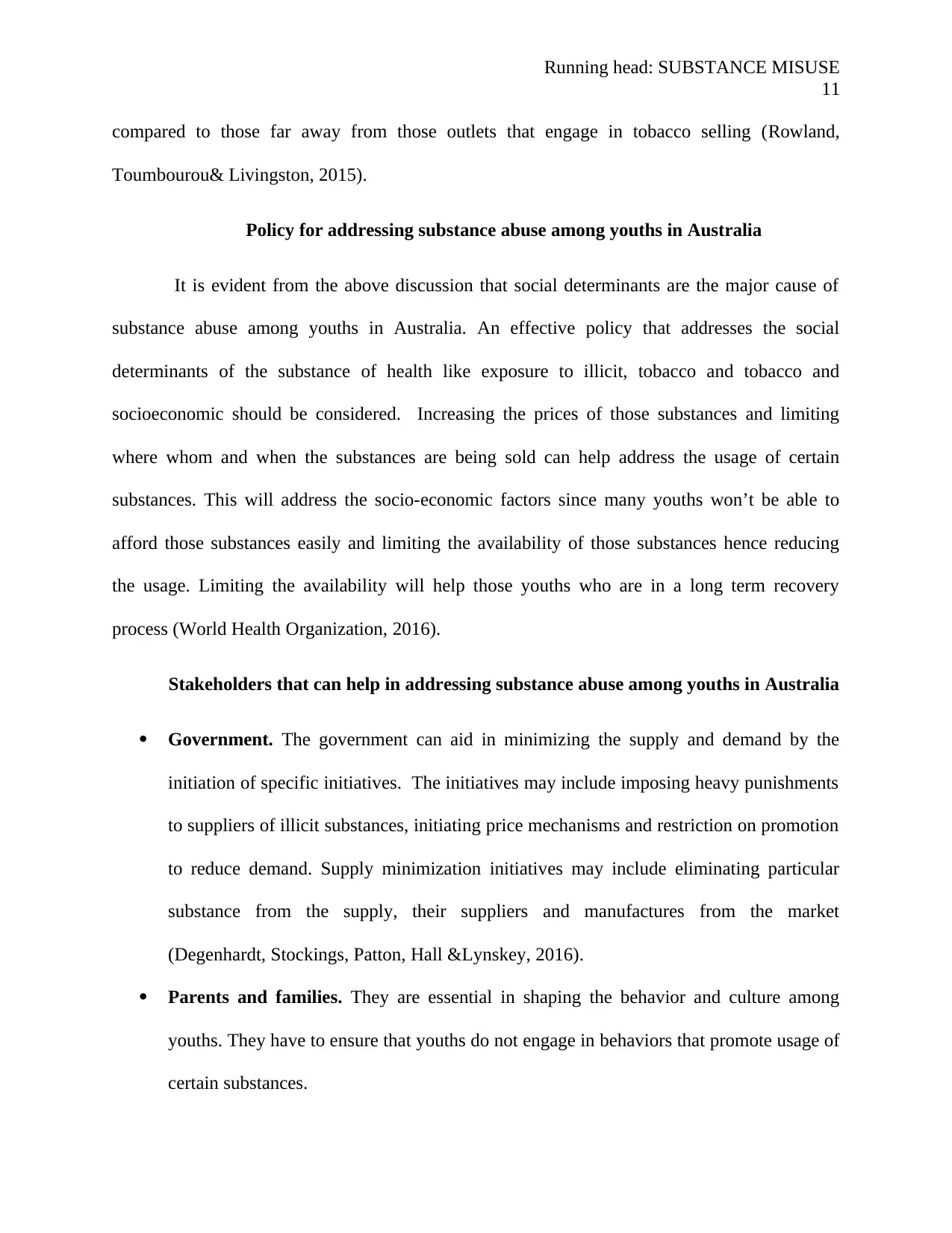
Running head: SUBSTANCE MISUSE
11
compared to those far away from those outlets that engage in tobacco selling (Rowland,
Toumbourou& Livingston, 2015).
Policy for addressing substance abuse among youths in Australia
It is evident from the above discussion that social determinants are the major cause of
substance abuse among youths in Australia. An effective policy that addresses the social
determinants of the substance of health like exposure to illicit, tobacco and tobacco and
socioeconomic should be considered. Increasing the prices of those substances and limiting
where whom and when the substances are being sold can help address the usage of certain
substances. This will address the socio-economic factors since many youths won’t be able to
afford those substances easily and limiting the availability of those substances hence reducing
the usage. Limiting the availability will help those youths who are in a long term recovery
process (World Health Organization, 2016).
Stakeholders that can help in addressing substance abuse among youths in Australia
Government. The government can aid in minimizing the supply and demand by the
initiation of specific initiatives. The initiatives may include imposing heavy punishments
to suppliers of illicit substances, initiating price mechanisms and restriction on promotion
to reduce demand. Supply minimization initiatives may include eliminating particular
substance from the supply, their suppliers and manufactures from the market
(Degenhardt, Stockings, Patton, Hall &Lynskey, 2016).
Parents and families. They are essential in shaping the behavior and culture among
youths. They have to ensure that youths do not engage in behaviors that promote usage of
certain substances.
11
compared to those far away from those outlets that engage in tobacco selling (Rowland,
Toumbourou& Livingston, 2015).
Policy for addressing substance abuse among youths in Australia
It is evident from the above discussion that social determinants are the major cause of
substance abuse among youths in Australia. An effective policy that addresses the social
determinants of the substance of health like exposure to illicit, tobacco and tobacco and
socioeconomic should be considered. Increasing the prices of those substances and limiting
where whom and when the substances are being sold can help address the usage of certain
substances. This will address the socio-economic factors since many youths won’t be able to
afford those substances easily and limiting the availability of those substances hence reducing
the usage. Limiting the availability will help those youths who are in a long term recovery
process (World Health Organization, 2016).
Stakeholders that can help in addressing substance abuse among youths in Australia
Government. The government can aid in minimizing the supply and demand by the
initiation of specific initiatives. The initiatives may include imposing heavy punishments
to suppliers of illicit substances, initiating price mechanisms and restriction on promotion
to reduce demand. Supply minimization initiatives may include eliminating particular
substance from the supply, their suppliers and manufactures from the market
(Degenhardt, Stockings, Patton, Hall &Lynskey, 2016).
Parents and families. They are essential in shaping the behavior and culture among
youths. They have to ensure that youths do not engage in behaviors that promote usage of
certain substances.
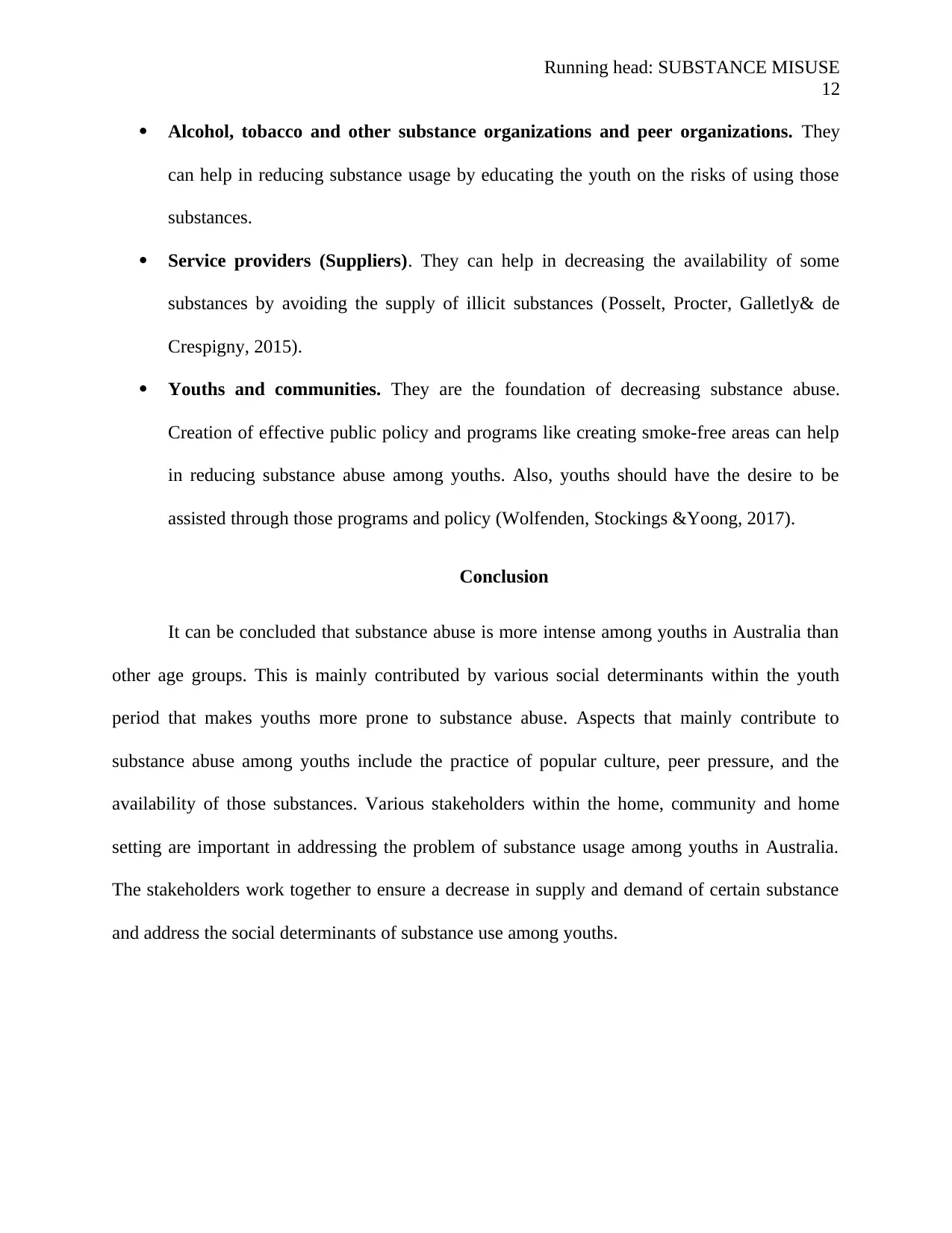
Running head: SUBSTANCE MISUSE
12
Alcohol, tobacco and other substance organizations and peer organizations. They
can help in reducing substance usage by educating the youth on the risks of using those
substances.
Service providers (Suppliers). They can help in decreasing the availability of some
substances by avoiding the supply of illicit substances (Posselt, Procter, Galletly& de
Crespigny, 2015).
Youths and communities. They are the foundation of decreasing substance abuse.
Creation of effective public policy and programs like creating smoke-free areas can help
in reducing substance abuse among youths. Also, youths should have the desire to be
assisted through those programs and policy (Wolfenden, Stockings &Yoong, 2017).
Conclusion
It can be concluded that substance abuse is more intense among youths in Australia than
other age groups. This is mainly contributed by various social determinants within the youth
period that makes youths more prone to substance abuse. Aspects that mainly contribute to
substance abuse among youths include the practice of popular culture, peer pressure, and the
availability of those substances. Various stakeholders within the home, community and home
setting are important in addressing the problem of substance usage among youths in Australia.
The stakeholders work together to ensure a decrease in supply and demand of certain substance
and address the social determinants of substance use among youths.
12
Alcohol, tobacco and other substance organizations and peer organizations. They
can help in reducing substance usage by educating the youth on the risks of using those
substances.
Service providers (Suppliers). They can help in decreasing the availability of some
substances by avoiding the supply of illicit substances (Posselt, Procter, Galletly& de
Crespigny, 2015).
Youths and communities. They are the foundation of decreasing substance abuse.
Creation of effective public policy and programs like creating smoke-free areas can help
in reducing substance abuse among youths. Also, youths should have the desire to be
assisted through those programs and policy (Wolfenden, Stockings &Yoong, 2017).
Conclusion
It can be concluded that substance abuse is more intense among youths in Australia than
other age groups. This is mainly contributed by various social determinants within the youth
period that makes youths more prone to substance abuse. Aspects that mainly contribute to
substance abuse among youths include the practice of popular culture, peer pressure, and the
availability of those substances. Various stakeholders within the home, community and home
setting are important in addressing the problem of substance usage among youths in Australia.
The stakeholders work together to ensure a decrease in supply and demand of certain substance
and address the social determinants of substance use among youths.
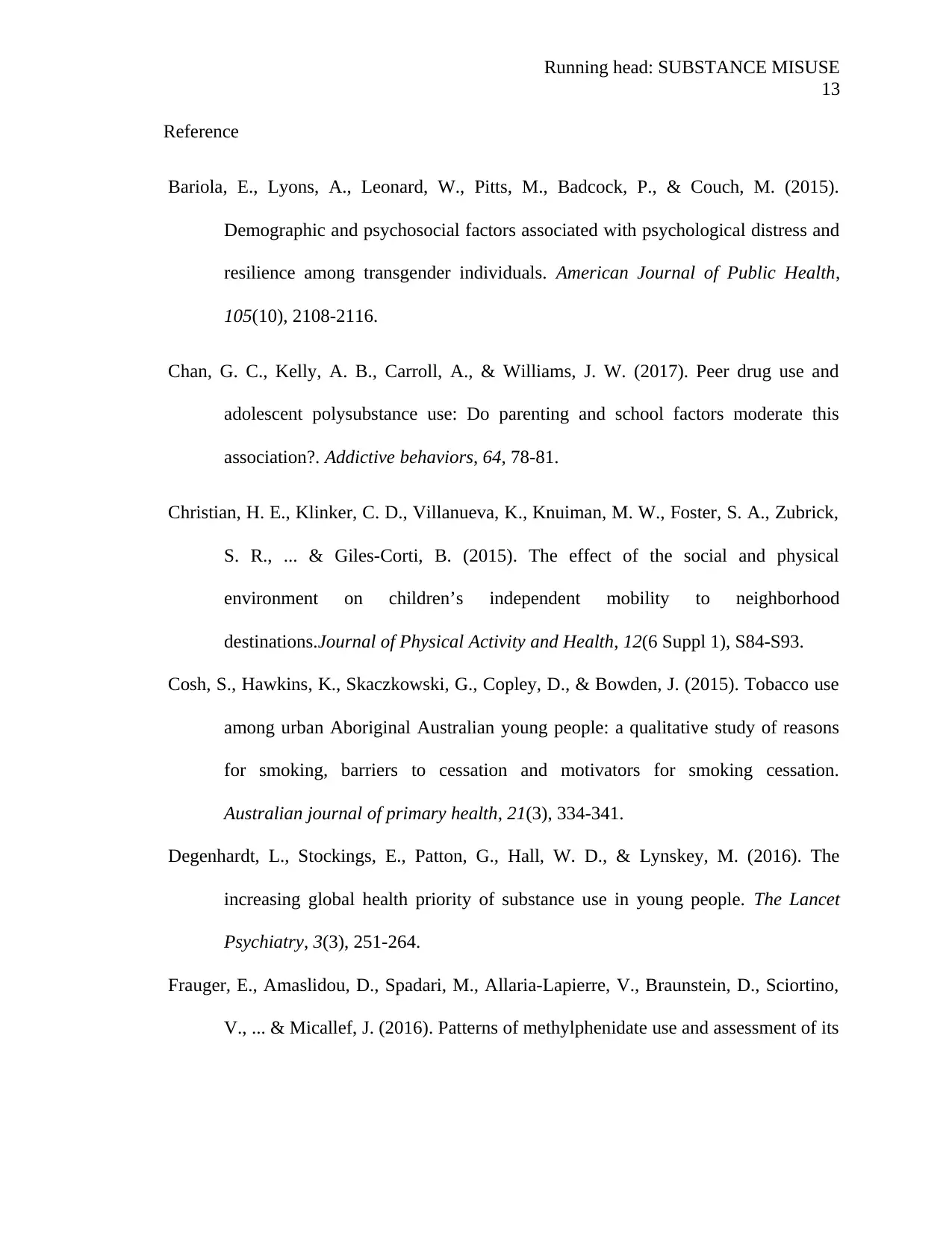
Running head: SUBSTANCE MISUSE
13
Reference
Bariola, E., Lyons, A., Leonard, W., Pitts, M., Badcock, P., & Couch, M. (2015).
Demographic and psychosocial factors associated with psychological distress and
resilience among transgender individuals. American Journal of Public Health,
105(10), 2108-2116.
Chan, G. C., Kelly, A. B., Carroll, A., & Williams, J. W. (2017). Peer drug use and
adolescent polysubstance use: Do parenting and school factors moderate this
association?. Addictive behaviors, 64, 78-81.
Christian, H. E., Klinker, C. D., Villanueva, K., Knuiman, M. W., Foster, S. A., Zubrick,
S. R., ... & Giles-Corti, B. (2015). The effect of the social and physical
environment on children’s independent mobility to neighborhood
destinations.Journal of Physical Activity and Health, 12(6 Suppl 1), S84-S93.
Cosh, S., Hawkins, K., Skaczkowski, G., Copley, D., & Bowden, J. (2015). Tobacco use
among urban Aboriginal Australian young people: a qualitative study of reasons
for smoking, barriers to cessation and motivators for smoking cessation.
Australian journal of primary health, 21(3), 334-341.
Degenhardt, L., Stockings, E., Patton, G., Hall, W. D., & Lynskey, M. (2016). The
increasing global health priority of substance use in young people. The Lancet
Psychiatry, 3(3), 251-264.
Frauger, E., Amaslidou, D., Spadari, M., Allaria-Lapierre, V., Braunstein, D., Sciortino,
V., ... & Micallef, J. (2016). Patterns of methylphenidate use and assessment of its
13
Reference
Bariola, E., Lyons, A., Leonard, W., Pitts, M., Badcock, P., & Couch, M. (2015).
Demographic and psychosocial factors associated with psychological distress and
resilience among transgender individuals. American Journal of Public Health,
105(10), 2108-2116.
Chan, G. C., Kelly, A. B., Carroll, A., & Williams, J. W. (2017). Peer drug use and
adolescent polysubstance use: Do parenting and school factors moderate this
association?. Addictive behaviors, 64, 78-81.
Christian, H. E., Klinker, C. D., Villanueva, K., Knuiman, M. W., Foster, S. A., Zubrick,
S. R., ... & Giles-Corti, B. (2015). The effect of the social and physical
environment on children’s independent mobility to neighborhood
destinations.Journal of Physical Activity and Health, 12(6 Suppl 1), S84-S93.
Cosh, S., Hawkins, K., Skaczkowski, G., Copley, D., & Bowden, J. (2015). Tobacco use
among urban Aboriginal Australian young people: a qualitative study of reasons
for smoking, barriers to cessation and motivators for smoking cessation.
Australian journal of primary health, 21(3), 334-341.
Degenhardt, L., Stockings, E., Patton, G., Hall, W. D., & Lynskey, M. (2016). The
increasing global health priority of substance use in young people. The Lancet
Psychiatry, 3(3), 251-264.
Frauger, E., Amaslidou, D., Spadari, M., Allaria-Lapierre, V., Braunstein, D., Sciortino,
V., ... & Micallef, J. (2016). Patterns of methylphenidate use and assessment of its
Paraphrase This Document
Need a fresh take? Get an instant paraphrase of this document with our AI Paraphraser
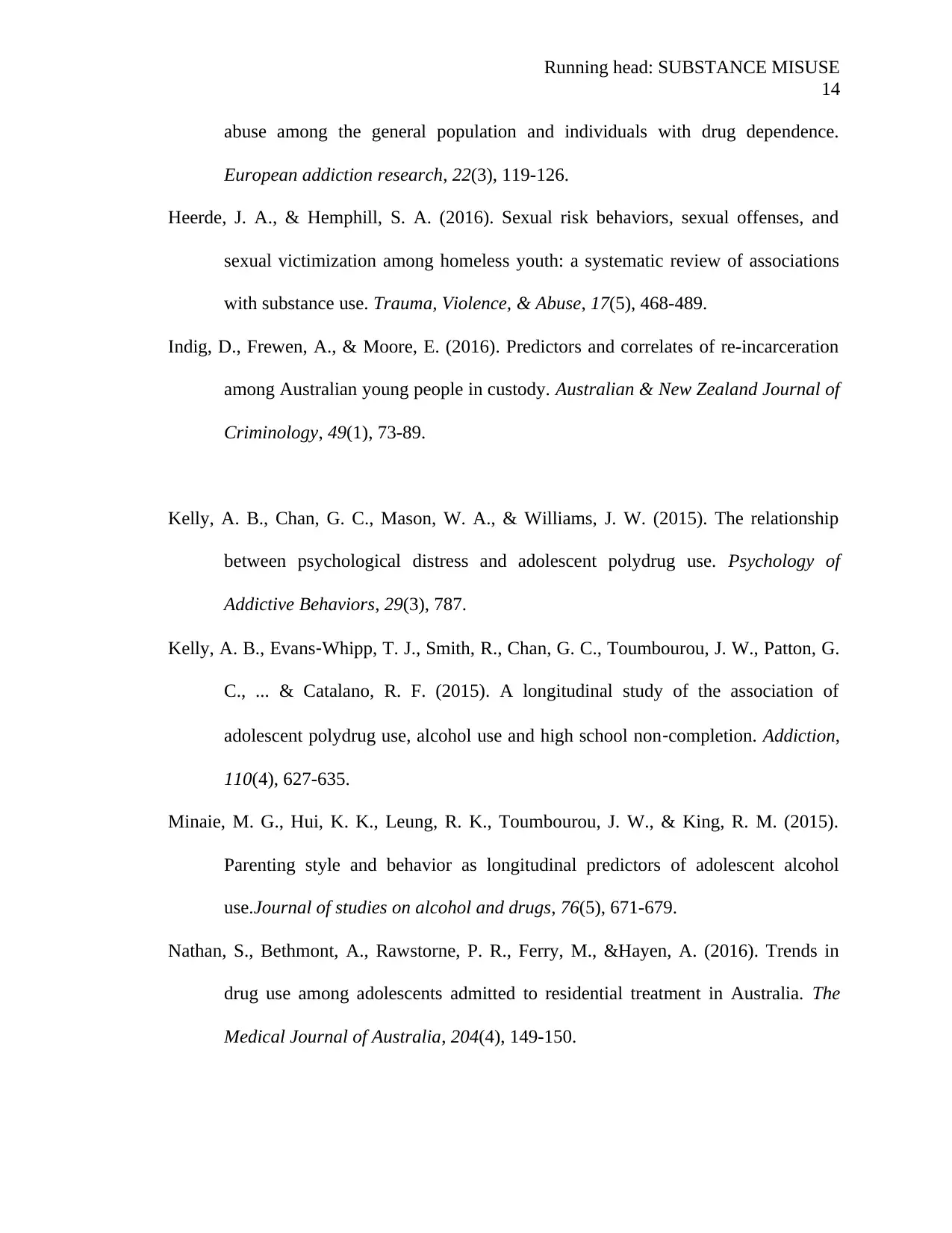
Running head: SUBSTANCE MISUSE
14
abuse among the general population and individuals with drug dependence.
European addiction research, 22(3), 119-126.
Heerde, J. A., & Hemphill, S. A. (2016). Sexual risk behaviors, sexual offenses, and
sexual victimization among homeless youth: a systematic review of associations
with substance use. Trauma, Violence, & Abuse, 17(5), 468-489.
Indig, D., Frewen, A., & Moore, E. (2016). Predictors and correlates of re-incarceration
among Australian young people in custody. Australian & New Zealand Journal of
Criminology, 49(1), 73-89.
Kelly, A. B., Chan, G. C., Mason, W. A., & Williams, J. W. (2015). The relationship
between psychological distress and adolescent polydrug use. Psychology of
Addictive Behaviors, 29(3), 787.
Kelly, A. B., Evans‐Whipp, T. J., Smith, R., Chan, G. C., Toumbourou, J. W., Patton, G.
C., ... & Catalano, R. F. (2015). A longitudinal study of the association of
adolescent polydrug use, alcohol use and high school non‐completion. Addiction,
110(4), 627-635.
Minaie, M. G., Hui, K. K., Leung, R. K., Toumbourou, J. W., & King, R. M. (2015).
Parenting style and behavior as longitudinal predictors of adolescent alcohol
use.Journal of studies on alcohol and drugs, 76(5), 671-679.
Nathan, S., Bethmont, A., Rawstorne, P. R., Ferry, M., &Hayen, A. (2016). Trends in
drug use among adolescents admitted to residential treatment in Australia. The
Medical Journal of Australia, 204(4), 149-150.
14
abuse among the general population and individuals with drug dependence.
European addiction research, 22(3), 119-126.
Heerde, J. A., & Hemphill, S. A. (2016). Sexual risk behaviors, sexual offenses, and
sexual victimization among homeless youth: a systematic review of associations
with substance use. Trauma, Violence, & Abuse, 17(5), 468-489.
Indig, D., Frewen, A., & Moore, E. (2016). Predictors and correlates of re-incarceration
among Australian young people in custody. Australian & New Zealand Journal of
Criminology, 49(1), 73-89.
Kelly, A. B., Chan, G. C., Mason, W. A., & Williams, J. W. (2015). The relationship
between psychological distress and adolescent polydrug use. Psychology of
Addictive Behaviors, 29(3), 787.
Kelly, A. B., Evans‐Whipp, T. J., Smith, R., Chan, G. C., Toumbourou, J. W., Patton, G.
C., ... & Catalano, R. F. (2015). A longitudinal study of the association of
adolescent polydrug use, alcohol use and high school non‐completion. Addiction,
110(4), 627-635.
Minaie, M. G., Hui, K. K., Leung, R. K., Toumbourou, J. W., & King, R. M. (2015).
Parenting style and behavior as longitudinal predictors of adolescent alcohol
use.Journal of studies on alcohol and drugs, 76(5), 671-679.
Nathan, S., Bethmont, A., Rawstorne, P. R., Ferry, M., &Hayen, A. (2016). Trends in
drug use among adolescents admitted to residential treatment in Australia. The
Medical Journal of Australia, 204(4), 149-150.
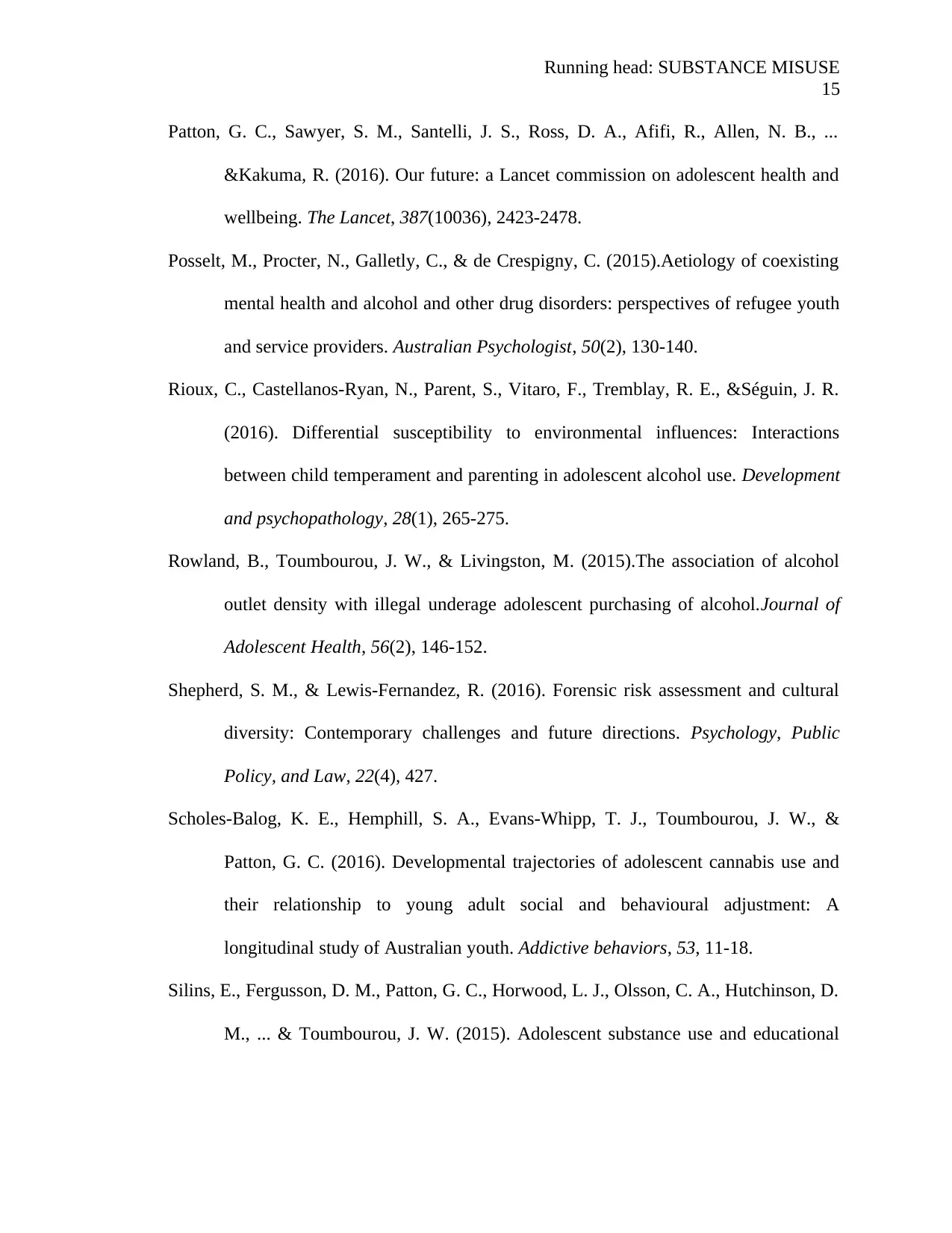
Running head: SUBSTANCE MISUSE
15
Patton, G. C., Sawyer, S. M., Santelli, J. S., Ross, D. A., Afifi, R., Allen, N. B., ...
&Kakuma, R. (2016). Our future: a Lancet commission on adolescent health and
wellbeing. The Lancet, 387(10036), 2423-2478.
Posselt, M., Procter, N., Galletly, C., & de Crespigny, C. (2015).Aetiology of coexisting
mental health and alcohol and other drug disorders: perspectives of refugee youth
and service providers. Australian Psychologist, 50(2), 130-140.
Rioux, C., Castellanos-Ryan, N., Parent, S., Vitaro, F., Tremblay, R. E., &Séguin, J. R.
(2016). Differential susceptibility to environmental influences: Interactions
between child temperament and parenting in adolescent alcohol use. Development
and psychopathology, 28(1), 265-275.
Rowland, B., Toumbourou, J. W., & Livingston, M. (2015).The association of alcohol
outlet density with illegal underage adolescent purchasing of alcohol.Journal of
Adolescent Health, 56(2), 146-152.
Shepherd, S. M., & Lewis-Fernandez, R. (2016). Forensic risk assessment and cultural
diversity: Contemporary challenges and future directions. Psychology, Public
Policy, and Law, 22(4), 427.
Scholes-Balog, K. E., Hemphill, S. A., Evans-Whipp, T. J., Toumbourou, J. W., &
Patton, G. C. (2016). Developmental trajectories of adolescent cannabis use and
their relationship to young adult social and behavioural adjustment: A
longitudinal study of Australian youth. Addictive behaviors, 53, 11-18.
Silins, E., Fergusson, D. M., Patton, G. C., Horwood, L. J., Olsson, C. A., Hutchinson, D.
M., ... & Toumbourou, J. W. (2015). Adolescent substance use and educational
15
Patton, G. C., Sawyer, S. M., Santelli, J. S., Ross, D. A., Afifi, R., Allen, N. B., ...
&Kakuma, R. (2016). Our future: a Lancet commission on adolescent health and
wellbeing. The Lancet, 387(10036), 2423-2478.
Posselt, M., Procter, N., Galletly, C., & de Crespigny, C. (2015).Aetiology of coexisting
mental health and alcohol and other drug disorders: perspectives of refugee youth
and service providers. Australian Psychologist, 50(2), 130-140.
Rioux, C., Castellanos-Ryan, N., Parent, S., Vitaro, F., Tremblay, R. E., &Séguin, J. R.
(2016). Differential susceptibility to environmental influences: Interactions
between child temperament and parenting in adolescent alcohol use. Development
and psychopathology, 28(1), 265-275.
Rowland, B., Toumbourou, J. W., & Livingston, M. (2015).The association of alcohol
outlet density with illegal underage adolescent purchasing of alcohol.Journal of
Adolescent Health, 56(2), 146-152.
Shepherd, S. M., & Lewis-Fernandez, R. (2016). Forensic risk assessment and cultural
diversity: Contemporary challenges and future directions. Psychology, Public
Policy, and Law, 22(4), 427.
Scholes-Balog, K. E., Hemphill, S. A., Evans-Whipp, T. J., Toumbourou, J. W., &
Patton, G. C. (2016). Developmental trajectories of adolescent cannabis use and
their relationship to young adult social and behavioural adjustment: A
longitudinal study of Australian youth. Addictive behaviors, 53, 11-18.
Silins, E., Fergusson, D. M., Patton, G. C., Horwood, L. J., Olsson, C. A., Hutchinson, D.
M., ... & Toumbourou, J. W. (2015). Adolescent substance use and educational
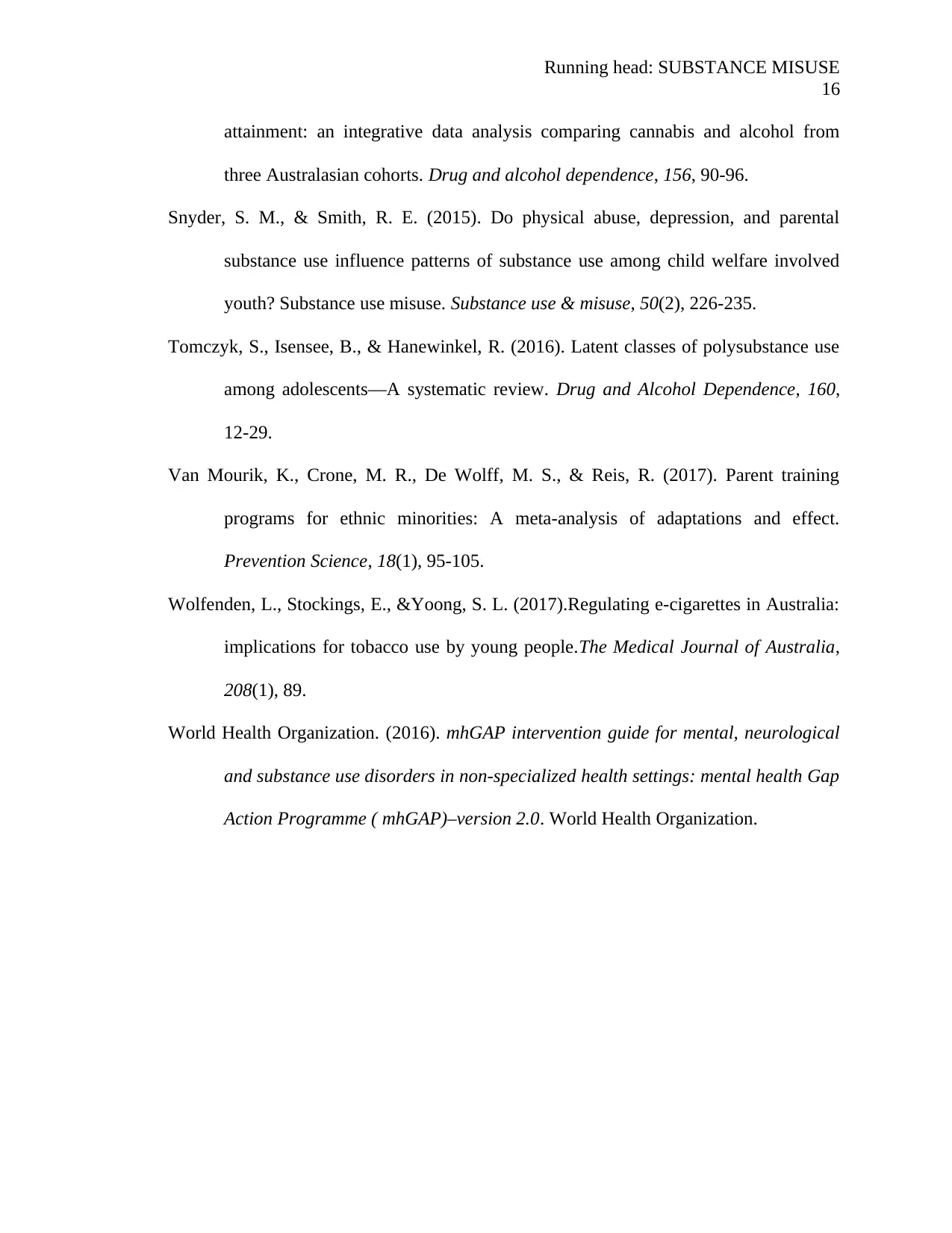
Running head: SUBSTANCE MISUSE
16
attainment: an integrative data analysis comparing cannabis and alcohol from
three Australasian cohorts. Drug and alcohol dependence, 156, 90-96.
Snyder, S. M., & Smith, R. E. (2015). Do physical abuse, depression, and parental
substance use influence patterns of substance use among child welfare involved
youth? Substance use misuse. Substance use & misuse, 50(2), 226-235.
Tomczyk, S., Isensee, B., & Hanewinkel, R. (2016). Latent classes of polysubstance use
among adolescents—A systematic review. Drug and Alcohol Dependence, 160,
12-29.
Van Mourik, K., Crone, M. R., De Wolff, M. S., & Reis, R. (2017). Parent training
programs for ethnic minorities: A meta-analysis of adaptations and effect.
Prevention Science, 18(1), 95-105.
Wolfenden, L., Stockings, E., &Yoong, S. L. (2017).Regulating e-cigarettes in Australia:
implications for tobacco use by young people.The Medical Journal of Australia,
208(1), 89.
World Health Organization. (2016). mhGAP intervention guide for mental, neurological
and substance use disorders in non-specialized health settings: mental health Gap
Action Programme ( mhGAP)–version 2.0. World Health Organization.
16
attainment: an integrative data analysis comparing cannabis and alcohol from
three Australasian cohorts. Drug and alcohol dependence, 156, 90-96.
Snyder, S. M., & Smith, R. E. (2015). Do physical abuse, depression, and parental
substance use influence patterns of substance use among child welfare involved
youth? Substance use misuse. Substance use & misuse, 50(2), 226-235.
Tomczyk, S., Isensee, B., & Hanewinkel, R. (2016). Latent classes of polysubstance use
among adolescents—A systematic review. Drug and Alcohol Dependence, 160,
12-29.
Van Mourik, K., Crone, M. R., De Wolff, M. S., & Reis, R. (2017). Parent training
programs for ethnic minorities: A meta-analysis of adaptations and effect.
Prevention Science, 18(1), 95-105.
Wolfenden, L., Stockings, E., &Yoong, S. L. (2017).Regulating e-cigarettes in Australia:
implications for tobacco use by young people.The Medical Journal of Australia,
208(1), 89.
World Health Organization. (2016). mhGAP intervention guide for mental, neurological
and substance use disorders in non-specialized health settings: mental health Gap
Action Programme ( mhGAP)–version 2.0. World Health Organization.
1 out of 16
Related Documents
Your All-in-One AI-Powered Toolkit for Academic Success.
+13062052269
info@desklib.com
Available 24*7 on WhatsApp / Email
![[object Object]](/_next/static/media/star-bottom.7253800d.svg)
Unlock your academic potential
© 2024 | Zucol Services PVT LTD | All rights reserved.





